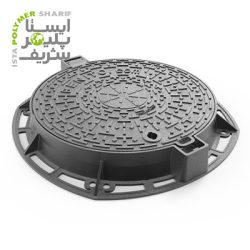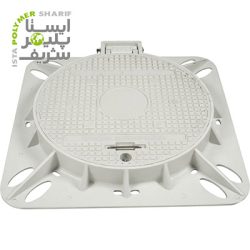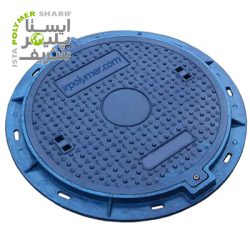What is a Handhole?
Handholes, also known as inspection chambers or telecommunication pits, are used for accessing underground utilities. Composite or polyethylene handholes manufactured by ABtank typically have a diameter less than 60 cm and are used for inspecting spaces where direct access is limited.
They are utilized for controlling underground drainage systems and inspecting facilities such as gas, electricity, telecommunications, etc. In case of any issues with these transmission pipelines, access through inspection covers like handhole doors or manhole covers facilitates control and repair. Based on their usage, they are classified into lightweight and heavy-duty types.
Components of Composite Telecommunication Handhole
These consist of two main parts: the body and the cover, each of which will be examined further:
Body of Handhole
The body serves as the access path to underground facilities. It resembles a pipe-like reservoir, manufactured by ABtank in various shapes such as rectangle, circle, or ellipse. The body material can be polyethylene, composite, steel, copper, etc. The opening of the body is sealed by the cover.
Cover
The cover is responsible for protecting the interior compartment of the body, preventing the entry of external factors such as water, light, dust, and other damaging elements. Covers are equipped with handles for easy removal and transportation.
The external appearance of handhole covers can vary, similar to their bodies. Composite handholes are among the most commonly used and high-quality types. It’s essential that the cover material is waterproof to prevent water ingress into the body.
Features of Composite Handhole Covers
Composite handhole covers possess several distinguishing features compared to other types:
- High durability
- Resistant to corrosion
- Prevents corrosion of internal equipment
- Easy sealing with pegs and metals
- Fire-resistant
- Waterproof
- Weather-resistant
- Long lifespan
- Capable of bearing loads exceeding 50 tons
- Easy installation
- No need for machinery or equipment during installation
- Easy transportation
- Cost-effective
- Resistant to wear and corrosion
- Chemical-resistant
- No need for internal and external coating
- Tracibility with devices
- Resistant to impact from heavy vehicles
- Applications of Composite Handholes in Telecommunications and Utilities
Types of Handholes
As mentioned, they are generally used for easy access to telecommunications systems, sewage, fiber optic networks, power cables, etc.
Electric Handholes, Telecommunications, and Fiber Optics
For underground transmission of electrical cables, they are placed inside polyethylene pipes and installed where needed for cables. The size of 400 is usually the most common.
Water Handholes
For easy access to the faucet valve of water transmission lines and installation of pressure gauges and other water transfer requirements, they use a 600 mm type.
Installation of Closed Circuit Cameras
It is used for the underground transfer of cables in places that include a large area.
Gas Transmission Network
In gas transmission lines, it is also used, such as water transmission lines and other requirements.
Types of Handhole Material
It is classified into three categories based on the materials used:
Polyethylene
It is made of polyethylene materials. They have high quality and durability because they are highly resistant to pressure and corrosion.
Composite
It is a combination of several types of materials. The composite type is mainly made of fiberglass. In these covers, glass fibers are used to the extent of polymers. Therefore, they are more resistant to concrete and polyethylene covers and have better resistance to pressure, corrosion, and longer life in different weather conditions.
Concrete
As the name implies, it is made of concrete and is used for underground facilities in streets. This makes it more affordable. However, the brittleness of these concrete doors has recently caused high-quality polymer concrete manhole cover. Are used, these covers and manhole covers are made of very resistant quality and cost-effective, and resistance to pressure and corrosion are good.
Classification of Composite Handholes
Composite handholes, such as manhole covers, have six classes of six, which in the table. Below specification and class features are the 6 classes
Class |
Load Capacity |
Application |
|---|---|---|
| A15 | 1.5 tons | Pedestrian walkways and bicycle paths |
| B125 | 12.5 tons | Pedestrian roads, areas such as parks |
| C250 | 25 tons | The edge of street tables. Maximum car to car 0.5 meters. 0 |
| D400 | 40 tons | For main street lanes |
| E600 | 60 tons | High-traffic areas for heavy vehicles such as docks and airports |
| F900 | 90 tons | Special locations capable of carrying heavy vehicles like airports |





